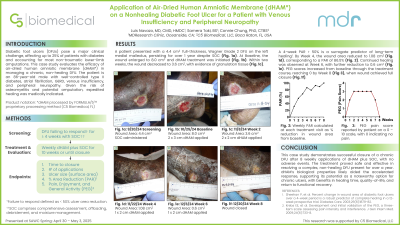Case Series/Study
(CS-107) Application of Air-dried Human Amniotic Membrane (dHAM*) on Nonhealing Diabetic Foot Ulcer for a Diabetic Patient with Venous Insufficiency and Peripheral Neuropathy

Air-dried human amniotic membrane (dHAM) is a sterile placental allograft derived from amniotic membrane tissue developed for wound healing. This clinical case study evaluates treatment outcomes for a patient with a nonhealing diabetic foot ulcer (DFU) managed with dHAM plus standard of care (SOC). Patient is an 86-year-old, non-smoking male with a BMI of 25-26 and PMH of well-managed DMII, atrial fibrillation, GERD, venous insufficiency, and peripheral neuropathy. Patient received SOC with topical wound dressings from the VA Outpatient Wound Clinic for over one year without improvement. Need for expedited healing arose as the wound persisted and risk of osteomyelitis and/or amputation increased.
Methods:
Patient presented with nonhealing, full thickness, Wagner 2 DFU on left medial malleolus that persisted over one year with SOC and nearly doubled in size in the five weeks prior to initial visit. At baseline, wound surface area was 8.0 cm2 and patient reported scores of 0 for all Pain, Enjoyment, and General Activity (PEG) parameters. Patient received dHAM plus modified SOC (compression, debridement, offloading, moisture management) weekly for eight weeks. Evaluation of wound healing was determined by time to closure, number of applications, percent area reduction from baseline (PAR), and PEG scale1 scores to assess pain and return to function. PAR >50% by a 4-week surrogate is an early prognostic indicator of effectiveness and predictive of long-term healing2.
Results: By the 4-week surrogate of weekly dHAM applications plus SOC, wound surface area measured 0.9 cm2, reflecting 88.8% PAR. PEG scores increased from baseline during treatment period, but returned to scores of 0 for all parameters by wound closure. In sum, eight applications of dHAM over eight weeks plus SOC augmented complete wound closure without adverse events.
Discussion: This case study highlights the safety and efficacy of dHAM treatment in healing a large, complex, nonhealing DFU that failed to heal with SOC alone for over one year. The biological properties of dHAM likely played a crucial role in achieving positive healing results. Therefore, dHAM is a noteworthy treatment option for chronic ulcers to promote faster healing, improved quality of life, and functional recovery.

.jpg)